Illusion and color perception
Akiyoshi Kitaoka
Department of Psychology, Ritsumeikan University
Presented at the 36th meeting of the Color Science Association of Japan using this page
University of Electro-Communications, Chofu, Tokyo, Japan, May 29, 2005
since May 25, 2005
1. Color contrast
It is said that the inset color is the same but appears to be different.
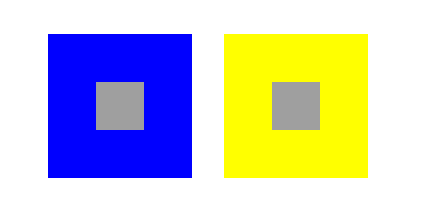
Is the left inset yellowish or is the right one bluish? The effect is weak.
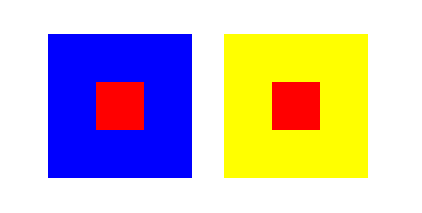
Does the left inset appear to be orange or does the right one appear to be magenta?
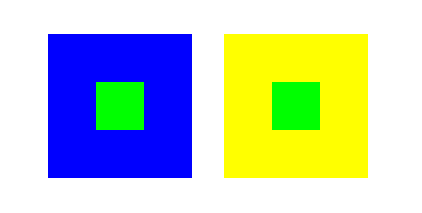
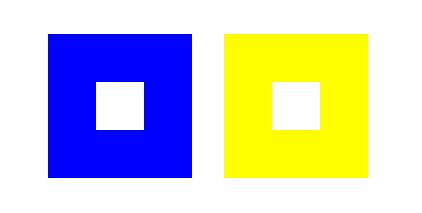
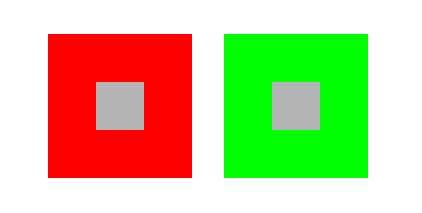
It looks reddish in the right inset.
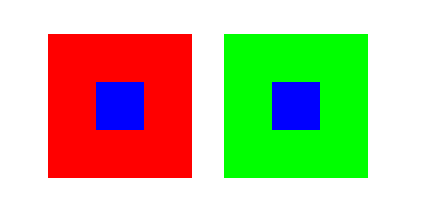
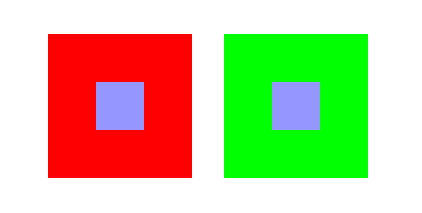
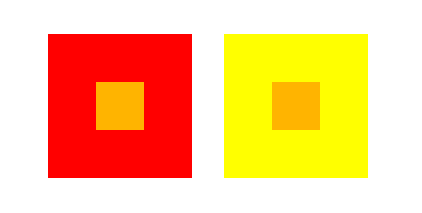
This looks better.
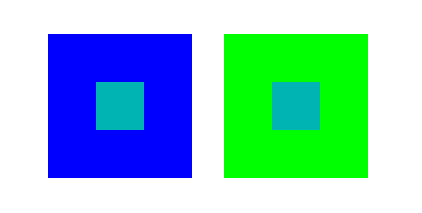
This looks better.
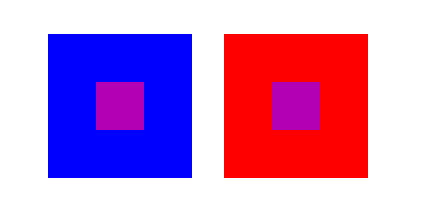
?
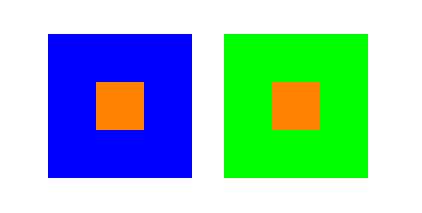
?
Kirschmann's (1891) formulation of color contrast
1. The smaller the test area, the larger the effect.
2. Color contrast occurs even if there is a spatial gap between the two fields. But the larger the gap, the smaller the effect.
3. The effect is maximum when brightness contrast is absent or weak.
4. The larger the size of the inducer, the larger the effect.
5. The higher the saturation of the inducer, the larger the effect.
Graham, C. H. and Brown, J. L. (1965) Color contrast and color appearance: Brightness constancy and color constancy. In C. H. Graham (Ed.), Vision and visual perception, New York: John Wiley & Sons (pp 452-478). (In this paper, the third and fourth laws are exchanged)
Kirschmann, A. (1891) Ueber die quantitativen Verhältnisse des stimultanen Helligkeits- und Farben-Contrastes. Philosophische Studien, 6, 417-491.
![]() Anyway, color contrast is weak in illusion magnitude.
Anyway, color contrast is weak in illusion magnitude.![]()
But, ...
2. Sakai's color contrast
The left inset appears to be gray but is the same color as the right inset.
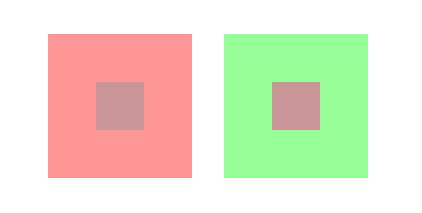
The right inset appears to be gray but is the same color as the left inset.
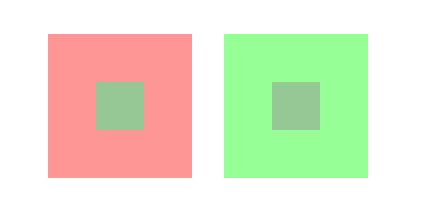
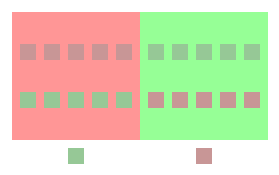
"Sakai's color contrast"
The squares of the upper row appear to be gray, but they are tinted as shown in the lower row that exchanges between the left fives and the right fives. This illusion is based upon a finding of Kasumi Sakai's graduational thesis (2003, Department of Psychology, Ritsumeikan University) entitled "Color representation by Land's retinex theory and Belsey's hypothesis" (in Japanese).
Copyright A.Kitaoka 2002
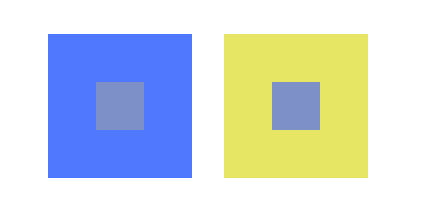
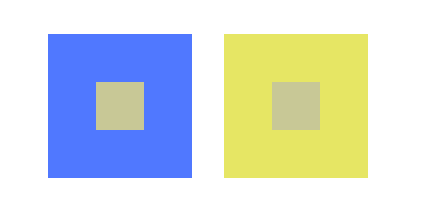
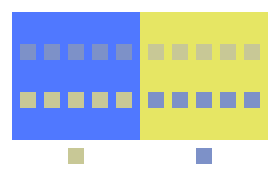
"Sakai's color contrast II"
The squares of the upper row appear to be gray, but they are tinted as shown in the lower row that exchanges between the left fives and the right fives. This illusion is based upon a finding of Kasumi Sakai's graduational thesis (2003, Department of Psychology, Ritsumeikan University) entitled "Color representation by Land's retinex theory and Belsey's hypothesis" (in Japanese).
Copyright Akiyoshi Kitaoka 2005 (May 25)
![]() Sakai's color contrast is strong in illusion magnitude.
Sakai's color contrast is strong in illusion magnitude.![]()
3. Enhanced color contrast
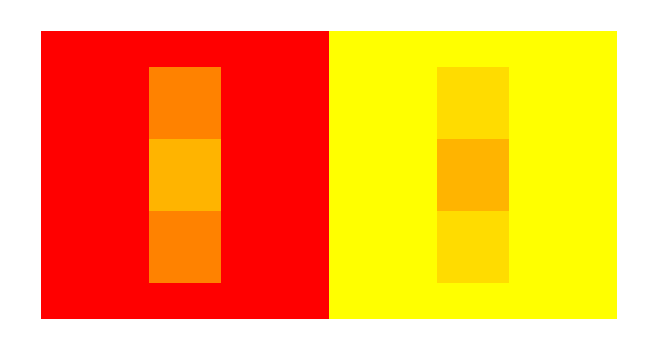
It appears that a = d or b = c in color, but actually b = d.
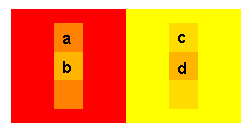
by Akiyoshi.Kitaoka 2005 (April 25)
This is not simply color contrast because removal of flanks reduces the effect (see the lower panel).

4. Color assimilation
The left gray background appears to be bluish while the right one to be yellowish.
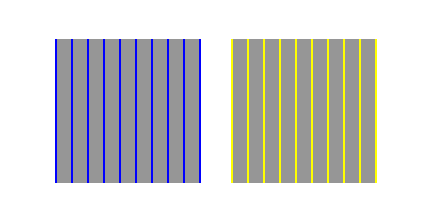

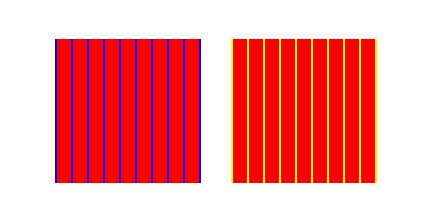

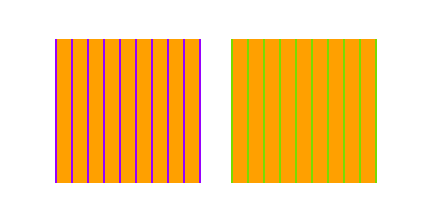

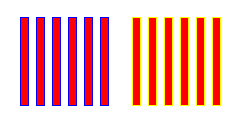
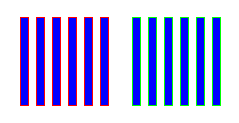
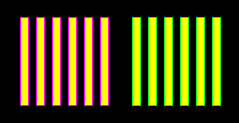
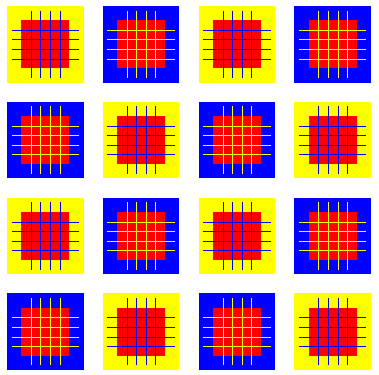
"Flowers"
Red appears to be magenta or orange. This is kind of von Bezold's chromatic assimilation.
Copyright A.Kitaoka 2001
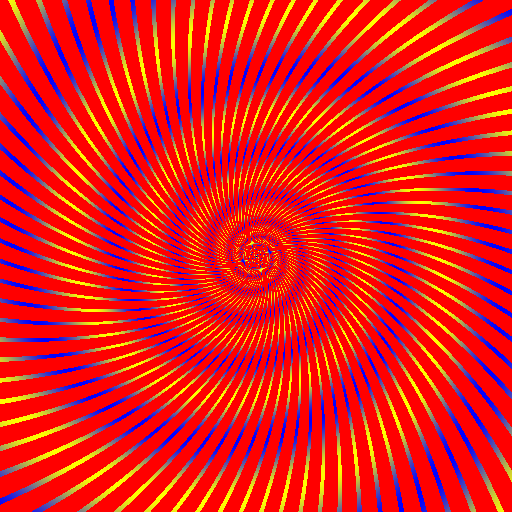
"Ascending dragons"
The red is homogeneous over the figure, but appears to be red-purple behind blue lines or to be orange behind yellow lines.
Copyright A.Kitaoka 2003
![]() Color assimilation is stronger in illusion magnitude than color contrast.
Color assimilation is stronger in illusion magnitude than color contrast.![]()
Neon color spreading
Color assimilation?
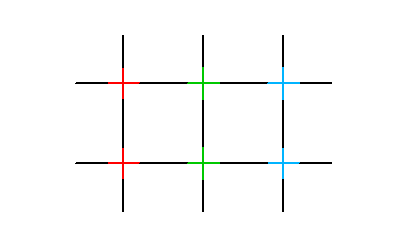
Varin, D. (1971) Fenomeni di contrasto e diffusione cromatica nell'organizzazione spaziale del campo percettivo. Rivista di Psicologia, 65, 101-128.
Van Tuijl, H. F. J. M. (1975). A new visual illusion: Neonlike color spreading and complementary color induction between subjective contours. Acta Psychologica, 39, 441-445.
Redies, C. and Spillmann, L. (1981). The neon color effect in the Ehrenstein illusion. Perception, 10, 667-681.
Chromatic pincushion grid illusion1)
Color assimilation?
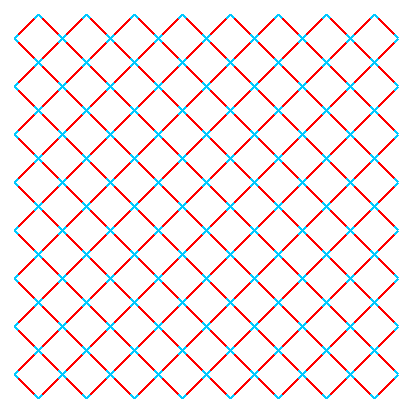
Illusory light-blue lines appear to run vertically or horizontally over the homogeneously white background. I think this phenomenon is closely related to "Spinnwebfaden"2) or "colored street"3).
Copyright Akiyoshi Kitaoka 2001
1) Kitaoka, A. (2001). Illusion designology (7): Illusory light perception that cannot be explained by the Fourier analysis. Nikkei Science, 31(8), 66-68 (in Japanese).
2) Prandtl, A. (1927). Uber gleichsinnege Induktion und die Lichtverteilung in gitterartigen Mustern. Zeitschrift fur Sinnesphysiologie, 58, 263-307.
3) Redies, C., Spillmann, L. and Kunz, K. (1984). Colored neon flanks and line gap enhancement. Vision Research, 24, 1301-1309.
Colored ray illusion
Color assimilation?
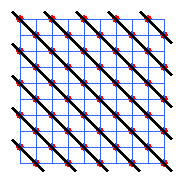
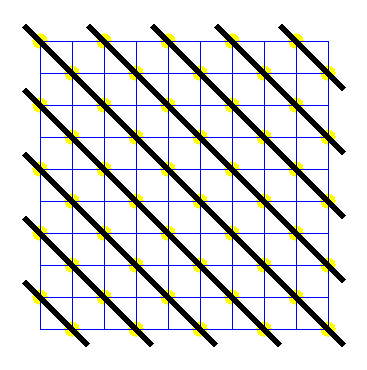
Illusory red lines appear to run obliquely over the homogeneously white background.
Copyright Akiyoshi Kitaoka 2001
Kitaoka, A. (2001). Illusion designology (7): Illusory light perception that cannot be explained by the Fourier analysis. Nikkei Science, 31(8), 66-68 (in Japanese).
Chromatic visual phantoms
Color assimilation?
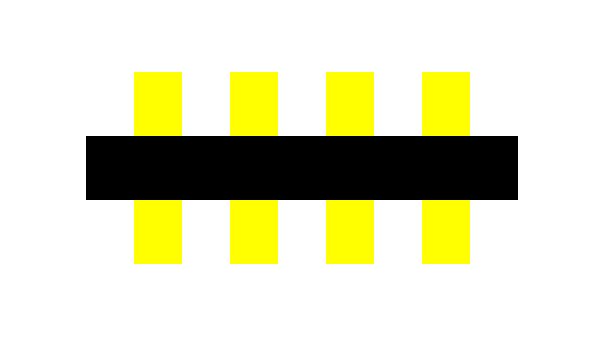
Kitaoka, A., Gyoba, J., and Kawabata, H. (1999). Photopic visual phantom illusion: Its common and unique characteristics as a completion effect. Perception, 28, 825-834.
Varin's figure
Color assimilation?
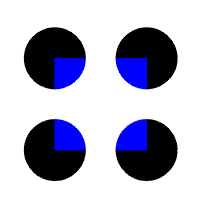
Varin, D. (1971) Fenomeni di contrasto e diffusione cromatica nell'organizzazione spaziale del campo percettivo. Rivista di Psicologia, 65, 101-128.
Watercolor illusion
Color assimilation?
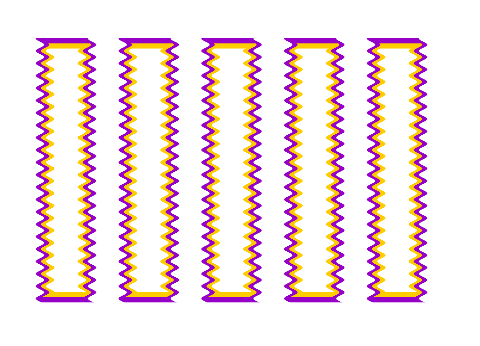
Pinna, B., Brelstaff, G., and Spillmann, L. (2001) Surface color from boundaries: a new 'watercolor' illusion. Vision Research, 41, 2669-2676.
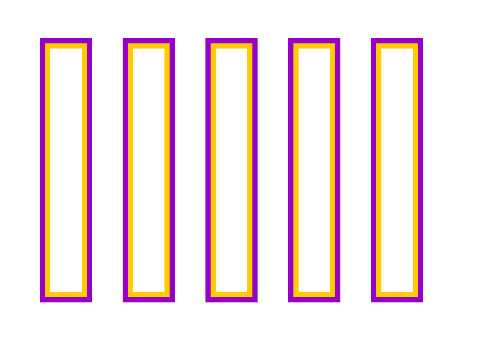
not so good
5. Munker illusion
(chromatic White's effect)
The same red appears to be orange or magenta in the upper panels, and the same green appears to be yellowish green or cyan.
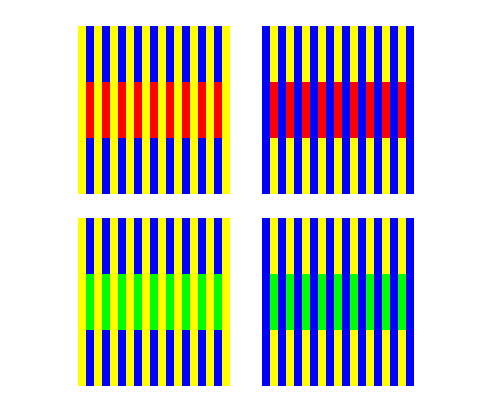
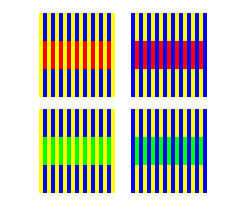
Munker, H. (1970) Farbige Gitter, Abbildung auf der Netzhauf und ubertragungstheoretische Beschreibung der Farbwahrnehmung. Munchen: Habilitationsschrift. More
White's effect
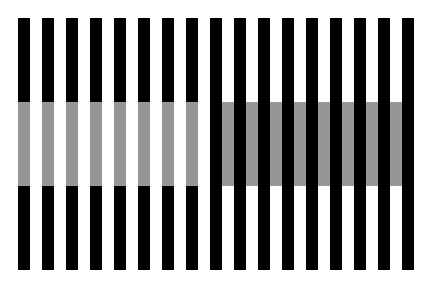

White, M. (1979) A new effect on perceived lightness. Perception, 8, 413-416.
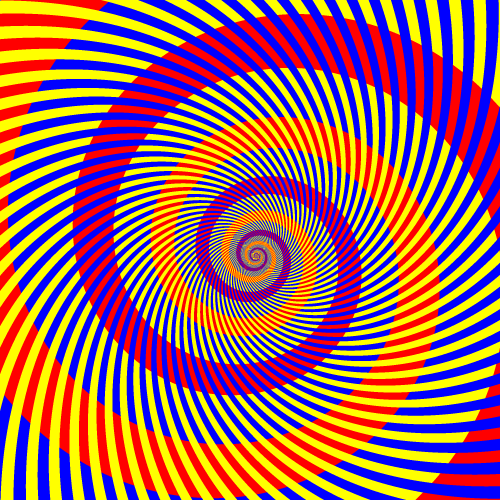
"Red spirals"
There appear to be spirals of two different types of red. Actually, they are identical.
Copyright
A.Kitaoka 2002
(c)Akiyoshi Kitaoka "Trick eyes" Tokyo: KANZEN 2002
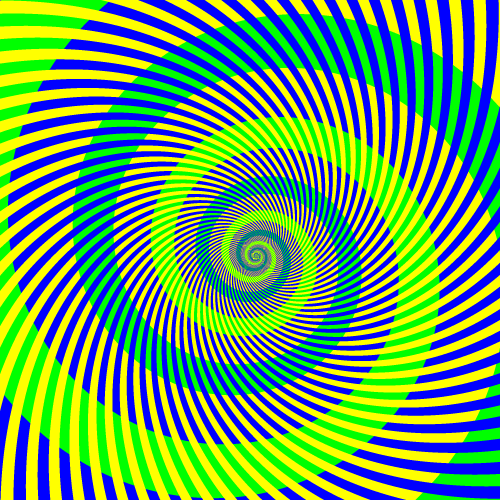
"Green spirals"
There appear to be spirals of two different types of green. Actually, they are identical.
Copyright
A.Kitaoka 2002
(c)Akiyoshi Kitaoka "Trick eyes" Tokyo: KANZEN 2002
T-junctions are not necessary for the Munker illusion if the grating is of high spatial frequency.
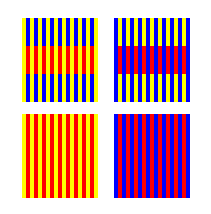
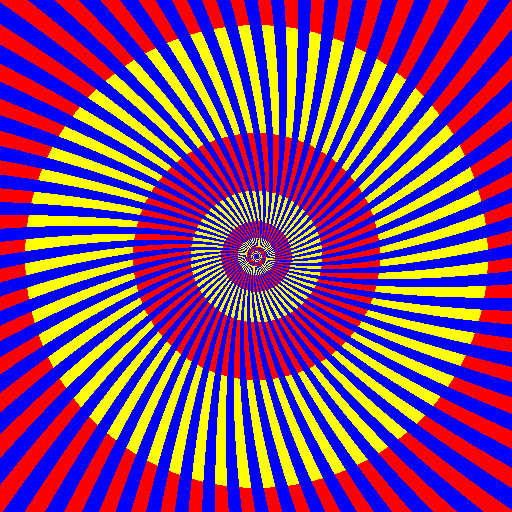
"Karakasa"*
*a kind of umbrella
The inside red appears to be purple-red.
Copyright A.Kitaoka 2002 (October 21, 2002)
Monnier-Shevell pattern
Monnier, P. and Shevell, S. K. (2003) Large shifts in color appearance from patterned chromatic backgrounds. Nature Neuroscience, 6, 801-802.
cf. Howe, P. D. L. (2005) White's effect: Removing the junctions but preserving the strength of the illusion. Perception, 34, 557 - 564.
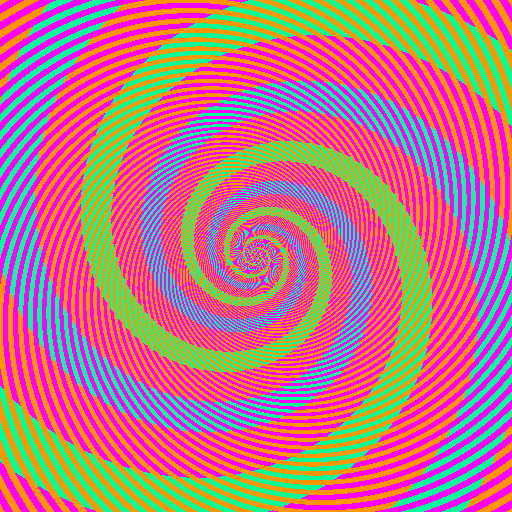
"Green and blue spirals"
There appear to be spirals of light green or light blue. Actually, they are identical (r = 0, g = 255, b = 150). I thought the basic illusion is given by Monnier and Shevell (2003), but this image might not match their theory...
Copyright A.Kitaoka 2003
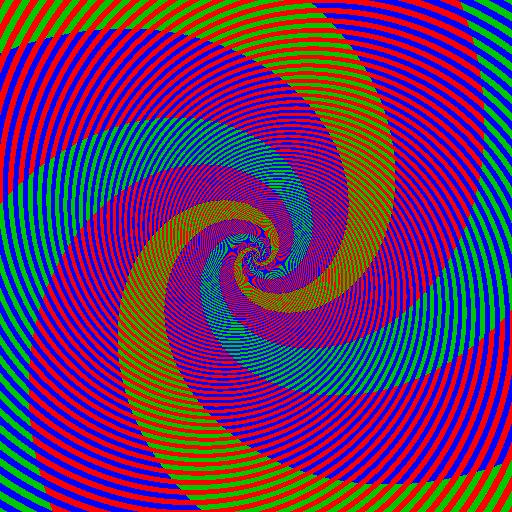
"Orochi"*
*Big snakes
There appear to be spirals of two different types of green. Actually, they are identical.
Copyright A.Kitaoka 2003
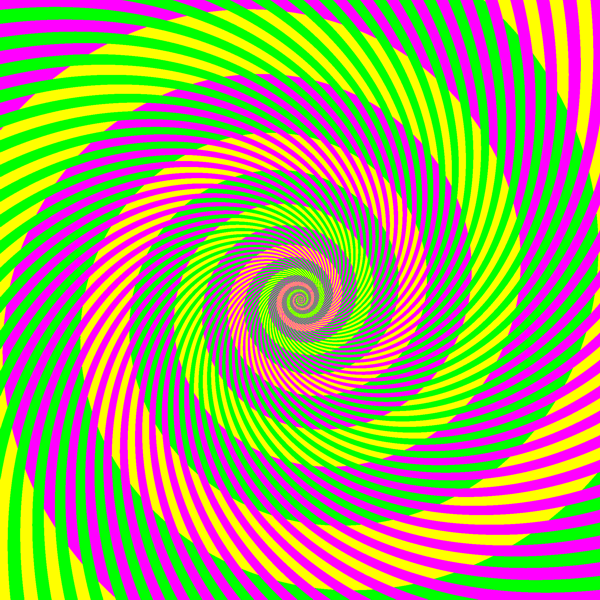
"Lemon-yellow spiral and cream-colored spiral"
It appears as if there were a lemon-yellow spiral and a cream-colored spiral, but the colors are identical (= yellow: R255, G255, B0).
Copyright Akiyoshi Kitaoka 2005 (April 22)
6. Remote color assimilation
The red close to blue appears to be magenta while the red close to yellow appears to be orange.
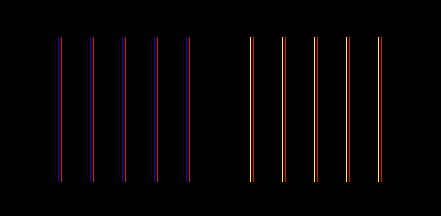
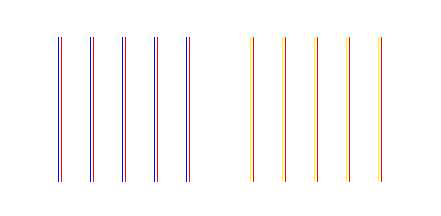
The green close to blue appears to be cyan while the green close to yellow appears to be yellowish-green.
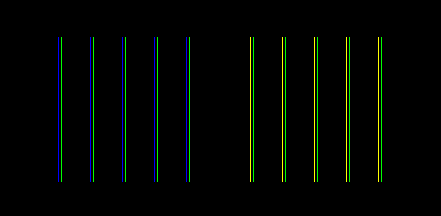
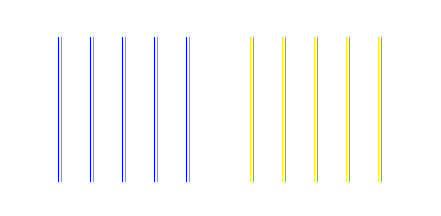
Kitaoka, A. (2001) Illusion designology VI: A new finding of instability in color. Nikkei Science, 31(7), 128-129.
7. Remote color contrast
The red placed a bit apart from blue appears to be orange while the red placed a bit apart from yellow appears to be magenta.
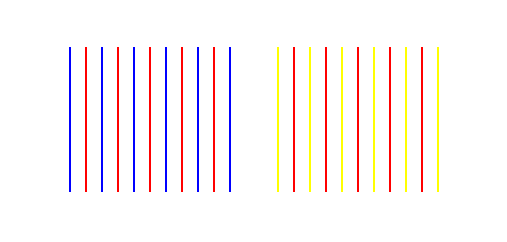
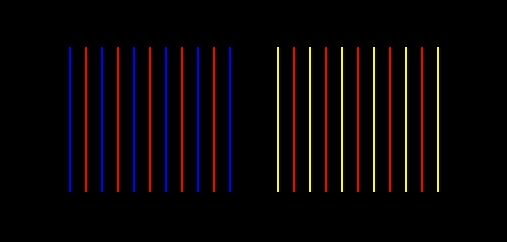
Kitaoka, A. (2001) Illusion designology VI: A new finding of instability in color. Nikkei Science, 31(7), 128-129.
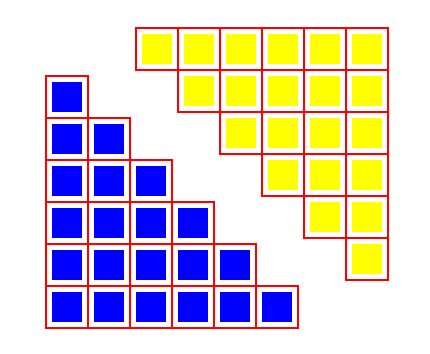
"Color scission"
The red surrounding blue appears to be orange while the red surrounding yellow appears to be magenta.
Copyright Aiyoshi Kitaoka 2005 (May 26)
Kirschmann's (1891) formulation of color contrast
2. Color contrast occurs even if there is a spatial gap between the two fields. But the larger the gap, the smaller the effect.
Remote color assimilation plus remote color contrast
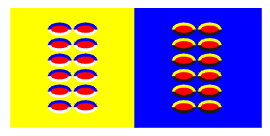
"Red glasses"
The red glasses in the right columns appear to be different in color from those in the left ones, though they are identical.
Copyright Akiyoshi Kitaoka 2005 (April 18)
Remote color assimilation plus remote color contrast
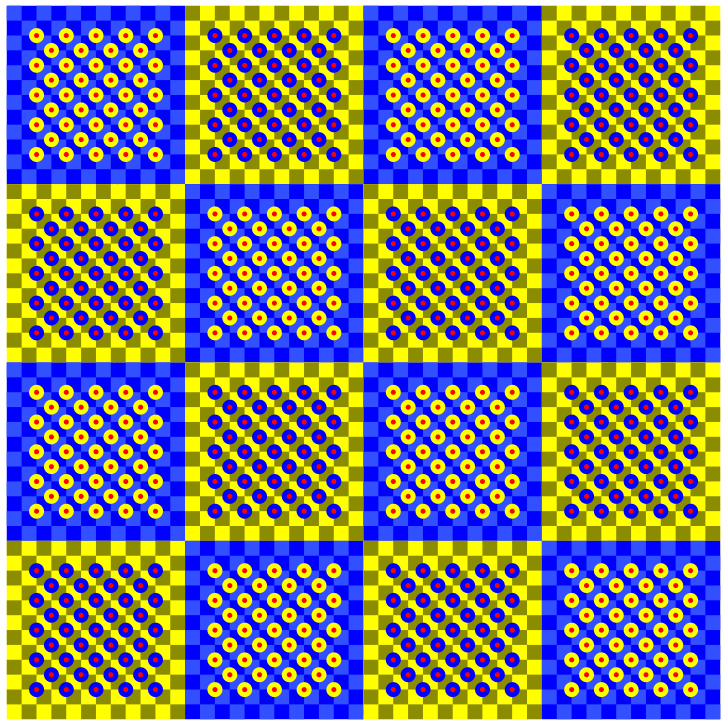
"A flower garden"
The same red appears to be orange or magenta.
Copyright Akiyoshi Kitaoka 2002
in Trick Eyes, 2002
reproduced in May 27, 2005
9. Chromatic scintillating illusion
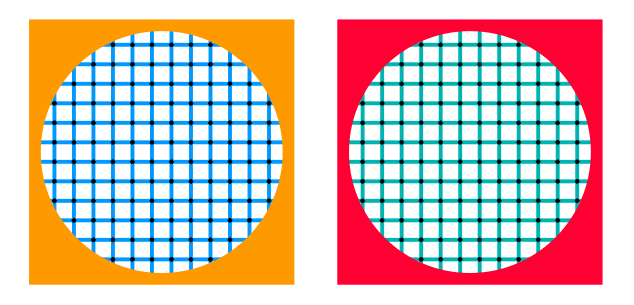
"Windows of enlightenment"
Black dots appear to
scintillate with orange or red light.
Copyright Aiyoshi Kitaoka 2005 (April 25)
The Window of Enlightenment is in the Genko-an temple, Kyoto, Japan.
Scintillating grid illusion
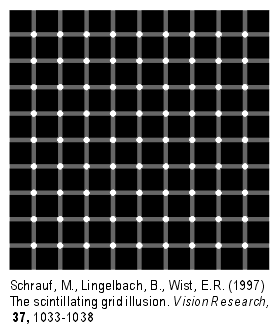
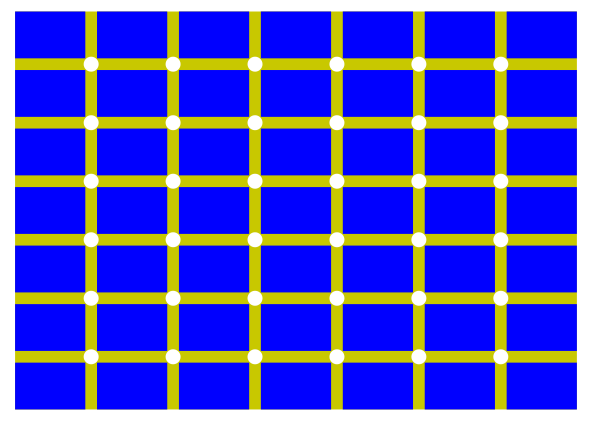
"Light of Sweden"
Blue light appears to scintillate in white circles.
Copyright Akiyoshi.Kitaoka 2005 (April 25)
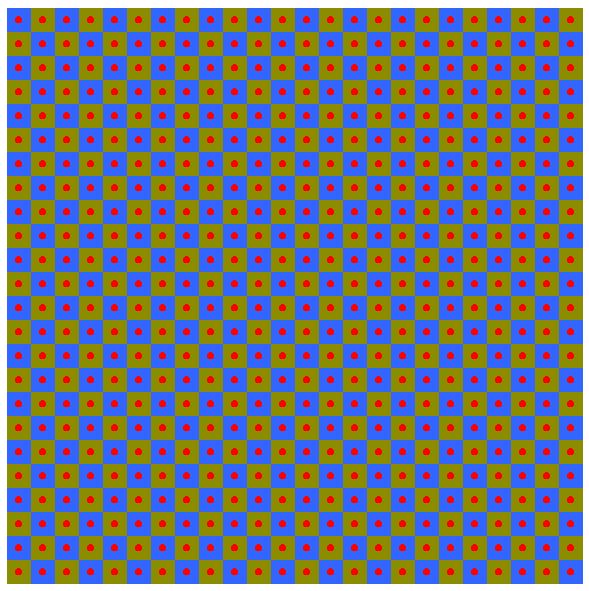
"The scintillating red illusion 2"
Red circles appear to scintillate.
Copyright A.Kitaoka 2003 (October 20)
This image may be dangerous. Please do not link to this image directly. Please do not upload this on your webpage.
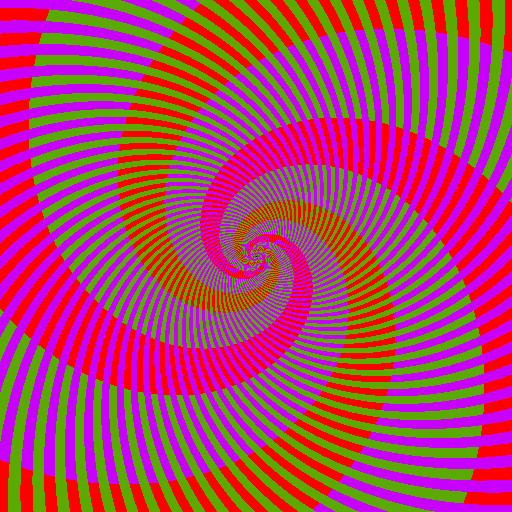
"Spirals of fluorescent color"
Red appears to be fluorescent color and scintillate. Moreover, red appears to be pink or orange in the center.
Copyright A.Kitaoka 2003 (October 17, 2003)
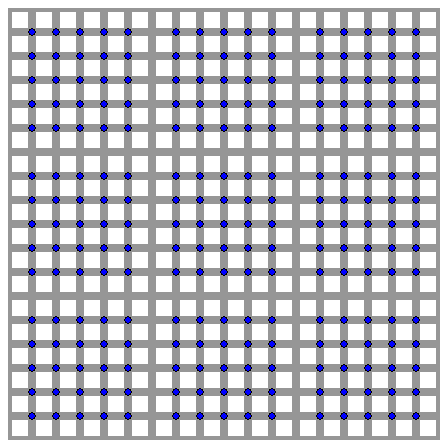
"Light of sapphires"
Blue dots appear to scintillate.
Copyright A.Kitaoka 2004 (June 18)
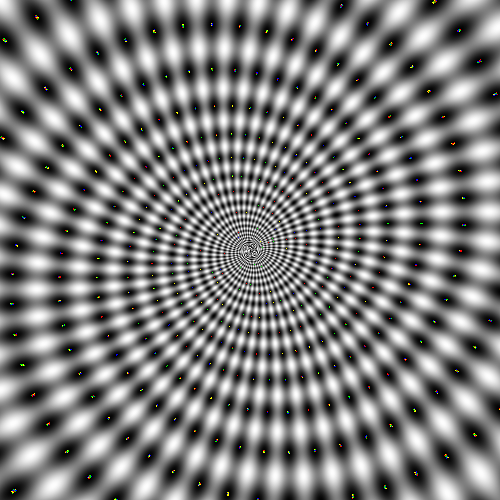
"Warp"
Stars appear to twinkle when we fixate on the center.
Copyright
A.Kitaoka 2003
(c)Akiyoshi Kitaoka "Trick eyes 2" Tokyo: KANZEN 2003
(The cover design of Trick Eyes 2)
9. Enhancement of blue
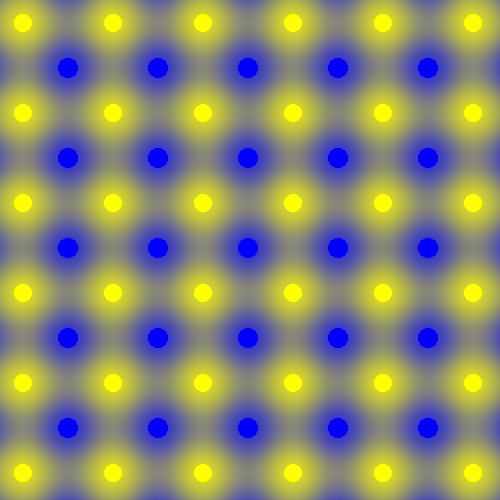
Blue circles appear to be enhanced in saturation when seen in the central vision.
Copyright A.Kitaoka 2003
10. Color changing illusion
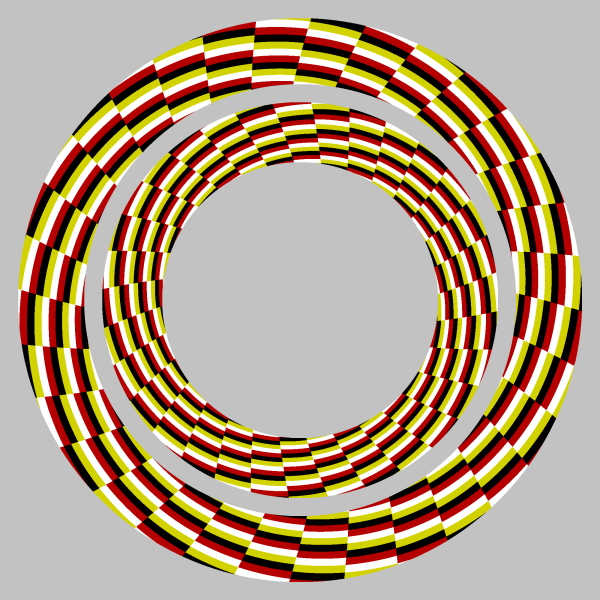
"Two rings"
The inner ring appears to
contract while the outer one appears to expand (peripheral drift
illusion). Moreover, the rings appear to rotate in the opposite directions
when observers approach or move away from the image fixating at the center
(Rotating Ouchi illusion, which will be published in the summer meeting of the Vision Society of Japan).
Furthermore, the inner ring appears to be more reddish when observers approach
the image fixating at the center, while the outer ring appears to be more
reddish when observers move away from the image. This image thus gives three
different illusions.
Copyright Aiyoshi Kitaoka 2005 (April 1)
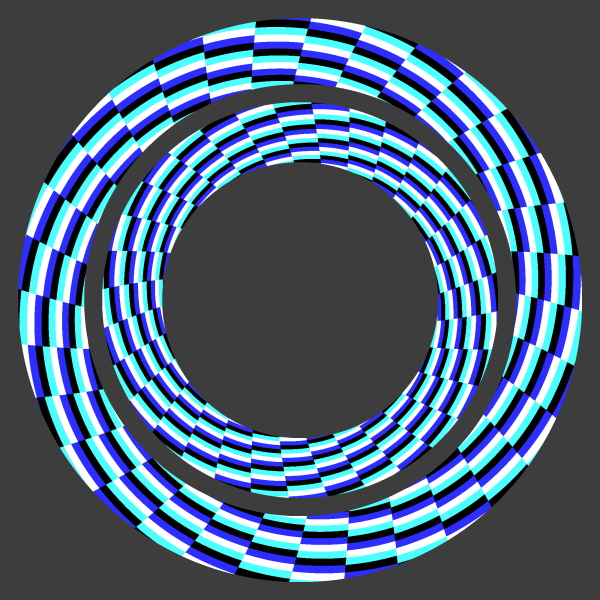
"Two rings"
The inner ring appears to be more sky-bluish when observers approach the
image fixating at the center, while the outer ring appears to be more sky-bluish
when observers move away from the image.
Copyright Aiyoshi Kitaoka 2005 (April 1)
Thank you.
Handout (scanned PDF)
Handout (PDF manuscript written in Japanese)
Handout (MS-Word manuscript written in Japanese)
Slightly modified on September 29, 2005